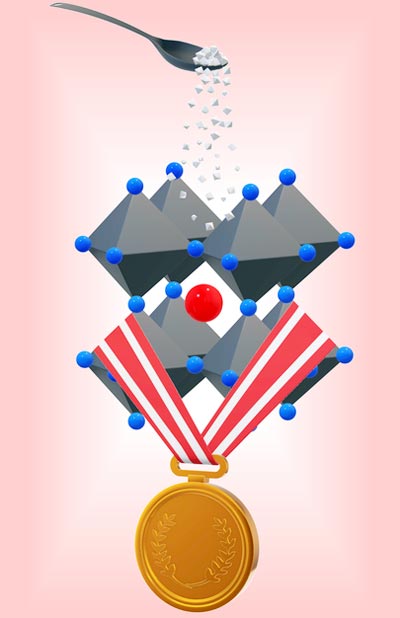
Perovskite Solar Cells Reach New Performance Milestones

Illustration Perovskite Solar Cells
Credit: © Yana Vaynzof / Christiane Kunath
Metal halide perovskites have been under intense investigation over the last decade, due to the remarkable rise in their performance in optoelectronic devices such as solar cells or light-emitting diodes. The most efficient devices, fabricated in the so called ‘standard architecture’ commonly include processing steps performed at high temperature, thus increasing their energy payback time and limiting the possibility to integrate them in emerging applications such as flexible and wearable electronics. An alternative device architecture – termed the ‘inverted architecture’ – eliminates the need for high temperature processing, but generally leads to a lower photovoltaic efficiency.
In a joint collaborative effort between the University of Pavia (Italy) and the Technische Universität Dresden (Germany), researchers have developed a novel method to significantly improve the efficiency of inverted architecture solar cells. The method is based on a modification of the interfaces of the perovskite active layer by introducing small amounts of organic halide salts at both the bottom and the top of the perovskite layer. Such organic halide salts, typically used for the formation of two-dimensional perovskites, led to the suppression of microstructural flaws and passivation of the defects of the perovskite layer. Using this approach, the team has achieved a power conversion efficiency of 23.7% – the highest reported to date for an inverted architecture perovskite solar cell.
“Importantly, the improvement in performance is accompanied by an increase in device stability” says Prof. Giulia Grancini, an Associate Professor of Chemistry at the University of Pavia. Considering that stability remains one of the key hurdles for the commercialization of perovskite solar cells, the simultaneous improvement of efficiency and stability is particularly promising.
“The fact that our devices are fabricated at low temperatures of less than 100° C and that our approach is fully applicable to the fabrication of large area devices takes us one step closer to large-scale utilization of perovskite solar cells” adds Prof. Yana Vaynzof, Chair for Emerging Electronic Technologies at the Institute for Applied Physics and Photonic Materials and the Center for Advancing Electronics Dresden (cfaed).
The record efficiency achieved by the researchers brings perovskite solar cells to new frontiers. Considering the enhanced stability and the scalability of the novel approach, it’s only a matter of time until perovskite solar cells can be found on every rooftop.
The work was now published in the prestigious journal “Science Advances”.
Title: 23.7% Efficient inverted perovskite solar cells by dual interfacial modification
Authors: Matteo Degani, Qingzhi An, Miguel Albaladejo-Siguan, Yvonne J. Hofstetter, Changsoon Cho, Fabian Paulus, Giulia Grancini and Yana Vaynzof
Sci. Adv. 7, eabj7930 (2021)
DOI: 10.1126/sciadv.abj7930
https://www.science.org/doi/10.1126/sciadv.abj7930
Journal: Science Advances
DOI: 10.1126/sciadv.abj7930
Article Title: 23.7% Efficient inverted perovskite solar cells by dual interfacial modification
Article Publication Date: 1-Dec-2021









![[Figure 1] Schematic of next-generation CNT-PANI composite fiber supercapacitor and comparison graph with recent results](https://www.innovations-report.com/wp-content/uploads/2025/05/KIST_leads_next-generation_energy_storage_technolo_1746783279-e1746784635527-362x245.jpg)


